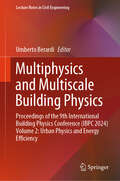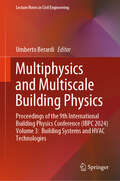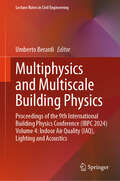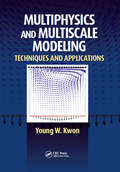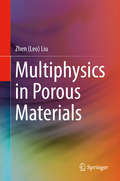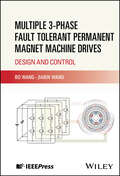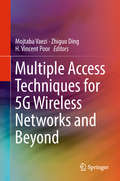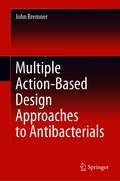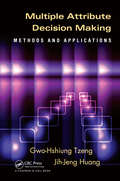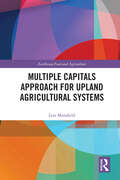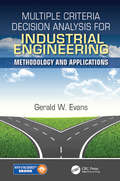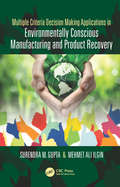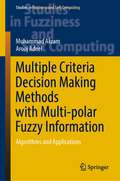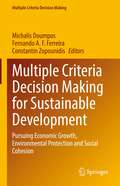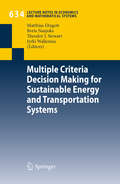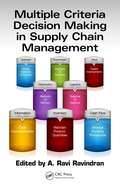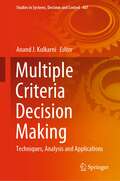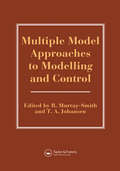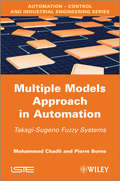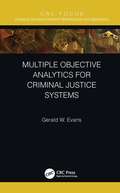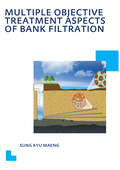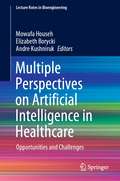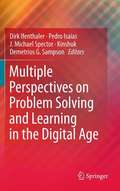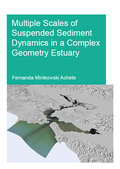- Table View
- List View
Multiphysics and Multiscale Building Physics: Proceedings of the 9th International Building Physics Conference (IBPC 2024) Volume 2: Urban Physics and Energy Efficiency (Lecture Notes in Civil Engineering #553)
by Umberto BerardiThis book contains selected papers presented at the 9th edition of the official triennial conference of the International Association of Building Physics (IABP), held in Toronto, Ontario, Canada on 25-27 July, 2024. The contents make valuable contributions to academic researchers and practioners of the building sector. Readers will encounter new ideas for realizing more efficient and resilient buildings and cities. The approach followed in the book aims to explore how building physics can be explored using multi domains and scales.
Multiphysics and Multiscale Building Physics: Proceedings of the 9th International Building Physics Conference (IBPC 2024) Volume 3: Building Systems and HVAC Technologies (Lecture Notes in Civil Engineering #554)
by Umberto BerardiThis book contains selected papers presented at the 9th edition of the official triennial conference of the International Association of Building Physics (IABP), held in Toronto, Ontario, Canada on 25-27 July, 2024. The contents make valuable contributions to academic researchers and practioners of the building sector. Readers will encounter new ideas for realizing more efficient and resilient buildings and cities. The approach followed in the book aims to explore how building physics can be explored using multi domains and scales.
Multiphysics and Multiscale Building Physics: Proceedings of the 9th International Building Physics Conference (IBPC 2024) Volume 4: Indoor Air Quality (IAQ), Lighting and Acoustics (Lecture Notes in Civil Engineering #555)
by Umberto BerardiThis book contains selected papers presented at the 9th edition of the official triennial conference of the International Association of Building Physics (IABP), held in Toronto, Ontario, Canada on 25-27 July, 2024. The contents make valuable contributions to academic researchers and practioners of the building sector. Readers will encounter new ideas for realizing more efficient and resilient buildings and cities. The approach followed in the book aims to explore how building physics can be explored using multi domains and scales.
Multiphysics and Multiscale Modeling: Techniques and Applications
by Young W. KwonWritten to appeal to a wide field of engineers and scientists who work on multiscale and multiphysics analysis, Multiphysics and Multiscale Modeling: Techniques and Applications is dedicated to the many computational techniques and methods used to develop man-made systems as well as understand living systems that exist in nature. Presenting a body
Multiphysics in Porous Materials
by Zhen Leo LiuThis book summarizes, defines, and contextualizes multiphysics with an emphasis on porous materials. It covers various essential aspects of multiphysics, from history, definition, and scope to mathematical theories, physical mechanisms, and numerical implementations. The emphasis on porous materials maximizes readers’ understanding as these substances are abundant in nature and a common breeding ground of multiphysical phenomena, especially complicated multiphysics. Dr. Liu’s lucid and easy-to-follow presentation serve as a blueprint on the use of multiphysics as a leading edge technique for computer modeling. The contents are organized to facilitate the transition from familiar, monolithic physics such as heat transfer and pore water movement to state-of-the-art applications involving multiphysics, including poroelasticity, thermohydro-mechanical processes, electrokinetics, electromagnetics, fluid dynamics, fluid structure interaction, and electromagnetomechanics. This volume serves as both a general reference and specific treatise for various scientific and engineering disciplines involving multiphysics simulation and porous materials.
Multiple 3-phase Fault Tolerant Permanent Magnet Machine Drives: Design and Control
by Bo Wang Jiabin WangGroundbreaking analysis of a fully functional fault-tolerant machine drive Electrical machine drives have become an increasingly important component of transportation electrification, including electric vehicles, railway and subway traction, aerospace actuation, and more. This expansion of electrical machine drives into safety-critical areas has driven an increasingly urgent demand for high reliability and strong fault tolerance. Machine drives incorporating a permanent magnet (PM)-assisted synchronous reluctance machine drive with a segregated winding have shown to exhibit notably reduced PM flux and correspondingly enhanced fault tolerance. Multiple 3-Phase Fault Tolerant Permanent Magnet Machine Drives: Design and Control offers one of the first fully integrated accounts of a functional fault-tolerant machine drive. It proposes a segregated winding which can be incorporated into multiple machine topologies without affecting performance and brings together cutting-edge technologies to manage these crucial drives in both healthy and fault conditions. The result is a must-own for engineers and researchers alike. Readers will also find: Advanced modeling techniques for different operation conditions Detailed discussion on topics including fault detection techniques, postfault tolerant control strategies, and many more An authorial team with immense experience in the study of fault-tolerant machine drives Multiple 3-Phase Fault Tolerant Permanent Magnet Machine Drives: Design and Control is ideal for researchers and graduate students in engineering and related industries.
Multiple Access Techniques for 5G Wireless Networks and Beyond
by H. Vincent Poor Mojtaba Vaezi Zhiguo DingThis book presents comprehensive coverage of current and emerging multiple access, random access, and waveform design techniques for 5G wireless networks and beyond. A definitive reference for researchers in these fields, the book describes recent research from academia, industry, and standardization bodies. The book is an all-encompassing treatment of these areas addressing orthogonal multiple access and waveform design, non-orthogonal multiple access (NOMA) via power, code, and other domains, and orthogonal, non-orthogonal, and grant-free random access. The book builds its foundations on state of the art research papers, measurements, and experimental results from a variety of sources.
Multiple Access Technology Towards Ubiquitous Networks: Overview and Efficient Designs
by Xiangming Li Kai Yang Jianping An Neng YeThis book investigates the multiuser communication and its key technology—multiple access technology, as well as transceiving design methods. Multiple access methods toward B5G and 6G currently allows the superposition transmissions of multiuser signals with controllable mutual interference. By deploying advanced multiuser detector, current technology significantly enhances the connectivity, improves the spectral efficiency and simplifies the signaling interactions. Considering that the major challenge of current multiple access technology is the design of transceiver due to the overlapped and distorted signals from multiple users, we analyze the promising candidate multiple access schemes and then develop some sights on how to formulate the transmit signals and how to achieve efficient symbol recovery. Specifically, the incorporation of constellation rotation, rate splitting and deep learning techniques in enhancing the transmission efficiency of multiple access technology are considered.
Multiple Action-Based Design Approaches to Antibacterials
by John BremnerThis book covers intentional design aspects for combinations of drugs, single-molecule hybrids with potential or actual multiple actions, pro-drugs which could yield multiple activity outcomes, and future possibilities. The approach of the book is interdisciplinary, and it provides greater understanding of the complex interplay of factors involved in the medicinal chemistry design and laboratory development of multiply active antibacterials. The scope of the book appeals to readers who are researching in the field of antibacterials using the approach of medicinal chemistry design and drug development.
Multiple Attribute Decision Making: Methods and Applications
by Gwo-Hshiung Tzeng Jih-Jeng HuangDecision makers are often faced with several conflicting alternatives. How do they evaluate trade-offs when there are more than three criteria? To help people make optimal decisions, scholars in the discipline of multiple criteria decision making (MCDM) continue to develop new methods for structuring preferences and determining the correct relative
Multiple Capitals Approach for Upland Agricultural Systems (Earthscan Food and Agriculture)
by Lois MansfieldThis book focuses on upland agricultural systems and applies a multiple capitals approach to explain what they can provide at a time when many are struggling to survive.Marginal upland agricultural systems have been distorted and derailed by modern economics, politics, and the drive to intensification. This book argues for the application of a multiple capitals approach to resource management challenges for marginal upland agricultural communities. Instead of considering what upland agricultural systems lack, the book showcases how a multiple capitals framework can demonstrate the importance, interrelationships, and relevance of the suite of capitals (natural, human, social, cultural, and financial) to achieve better outcomes for upland communities, broader ecosystem services, and wider society more generally. It is designed to connect theory to practice to provide underpinning knowledge and guidance to help upland agricultural communities thrive. Drawing on case studies from the UK and Japan, as well as making comparisons with Central and South American countries, the book recommends tools for monitoring different forms of capital and suggests a management process driven by multiple capitals to create resilience in upland agricultural systems.This book will be of great interest to students and scholars of agriculture, natural resource management, ecosystem services, rural development, and those interested in applying a multiple capitals approach more widely within policy and landscape management contexts.
Multiple Criteria Decision Analysis for Industrial Engineering: Methodology and Applications (Operations Research Series)
by Gerald William EvansThis textbook presents methodologies and applications associated with multiple criteria decision analysis (MCDA), especially for those students with an interest in industrial engineering. With respect to methodology, the book covers (1) problem structuring methods; (2) methods for ranking multi-dimensional deterministic outcomes including multiattribute value theory, the analytic hierarchy process, the Technique for Order Preference by Similarity to Ideal Solution (TOPSIS), and outranking techniques; (3) goal programming,; (4) methods for describing preference structures over single and multi-dimensional probabilistic outcomes (e.g., utility functions); (5) decision trees and influence diagrams; (6) methods for determining input probability distributions for decision trees, influence diagrams, and general simulation models; and (7) the use of simulation modeling for decision analysis. This textbook also offers: · Easy to follow descriptions of how to apply a wide variety of MCDA techniques · Specific examples involving multiple objectives and/or uncertainty/risk of interest to industrial engineers · A section on outranking techniques ; this group of techniques, which is popular in Europe, is very rarely mentioned as a methodology for MCDA in the United States · A chapter on simulation as a useful tool for MCDA, including ranking & selection procedures. Such material is rarely covered in courses in decision analysis · Both material review questions and problems at the end of each chapter . Solutions to the exercises are found in the Solutions Manual which will be provided along with PowerPoint slides for each chapter. The methodologies are demonstrated through the use of applications of interest to industrial engineers, including those involving product mix optimization, supplier selection, distribution center location and transportation planning, resource allocation and scheduling of a medical clinic, staffing of a call center, quality control, project management, production and inventory control,and so on. Specifically, industrial engineering problems are structured as classical problems in multiple criteria decision analysis, and the relevant methodologies are demonstrated.
Multiple Criteria Decision Making Applications in Environmentally Conscious Manufacturing and Product Recovery
by Surendra M. Gupta Mehmet Ali IlginIn order to ensure environmentally responsible production and disposal of products, local governments are imposing stricter environmental regulations, some of which even require manufacturers to take back their products at the end of the product's useful life. These government regulations, together with increasing environmental awareness, have forced manufacturers to invest in environment-conscious manufacturing. The multiple Criteria Decision Making Techniques presented in this book can be employed to solve the problems of environment-conscious manufacturers in product design, logistics, disassembly and remanufacturing.
Multiple Criteria Decision Making Methods with Multi-polar Fuzzy Information: Algorithms and Applications (Studies in Fuzziness and Soft Computing #430)
by Muhammad Akram Arooj AdeelThis book presents an extension of fuzzy set theory allowing for multi-polar information, discussing its impact on the theoretical and practical development of multi-criteria decision making. It reports on set of hybrid models developed by the authors, and show how they can be adapted, case by case, to the lack of certainty under a variety of criteria. Among them, hybrid models combining m-polar fuzzy sets with rough, soft and 2-tuple linguistic sets, and m-polar hesitant fuzzy sets and hesitant m-polar fuzzy are presented, together with some significant applications. In turn, outranking decision-making techniques such as m-polar fuzzy ELECTRE I, II, III and IV methods, as well as m-polar fuzzy PROMETHEE I and II methods, are developed. The efficiency of these decision-making procedures, as well as other possible extensions studied by the authors, is shown in some real-world applications. Overall, this book offers a guide on methodologies to deal with the multi-polarity and fuzziness of the real-world problems, simultaneously. By including algorithms and computer programming codes, it provides a practice-oriented reference guide to both researchers and professionals working at the interface between computational intelligence and decision making.
Multiple Criteria Decision Making for Sustainable Development: Pursuing Economic Growth, Environmental Protection and Social Cohesion (Multiple Criteria Decision Making)
by Constantin Zopounidis Michalis Doumpos Fernando A. F. FerreiraThis book presents a rich collection of studies on the analysis of sustainable development from a multiple criteria decision-making (MCDM) perspective, written by some of the most prominent authors in the field of MCDM/A. The book constitutes a unique international reference guide to the analysis, measurement, and management of sustainability in a multidimensional decision analysis context. Chiefly intended for academics and policymakers, it reflects some of the latest methodological advances in decision-making, which are illustrated in real-life applications to sustainability-related topics in both the private and public sector.
Multiple Criteria Decision Making for Sustainable Energy and Transportation Systems
by Theodor Stewart Jyrki Wallenius Boris Naujoks Matthias EhrgottIn the twenty-first century the sustainability of energy and transportation systems is on the top of the political agenda in many countries around the world. Environmental impacts of human economic activity necessitate the consideration of conflicting goals in decision making processes to develop sustainable systems. Any sustainable development has to reconcile conflicting economic and environmental objectives and criteria. The science of multiple criteria decision making has a lot to offer in addressing this need. Decision making with multiple (conflicting) criteria is the topic of research that is at the heart of the International Society of Multiple Criteria Decision Making. This book is based on selected papers presented at the societies 19th International Conference, held at The University of Auckland, New Zealand, from 7th to 12th January 2008 under the theme "MCDM for Sustainable Energy and Transportation Systems''.
Multiple Criteria Decision Making in Supply Chain Management (Operations Research Series)
by A. Ravi RavindranSupply chain management decisions are made under the conflicting criteria of maximizing profit and customer responsiveness while minimizing supply chain risk. Multiple Criteria Decision Making in Supply Chain Management provides a comprehensive overview of multi-criteria optimization models and methods that can be used in supply chain decision making.Presenting the contributions of internationally known authors, researchers, educators, and practitioners, this new book in the Operations Research Series provides readers with a single source guide to recent developments in this area. The focus of the book is on the design and operation of the supply chain system, which involves connecting many production and distribution systems, often across wide geographic distances, in such a way that the businesses involved can ultimately satisfy the consumer demand as efficiently as possible, resulting in maximum financial returns to those businesses connected to that supply chain system. The book includes several case studies on the design and operation of supply chain networks in manufacturing and healthcare.
Multiple Criteria Decision Making: Techniques, Analysis and Applications (Studies in Systems, Decision and Control #407)
by Anand J. KulkarniThe book discusses state-of-the-art applications and methodologies of the Multiple Criteria Decision Making (MCDM) techniques and approaches. The book focuses on critical literature, underlying principles of methods and models, solution approaches, testing and validation, real-world applications, case studies, etc. The book helps evaluate strategic decision-making through advanced MCDM and integrated approaches of AI, big data, and IoT to provide realistic and robust solutions to the current problems. The book will be a guideline to the potential MCDM researchers about the choice of approaches for dealing with the complexities and modalities. The contributions of the book help readers to explore new avenues leading towards multidisciplinary research discussions. This book will be interesting for engineers, scientists, and students studying/working in the related areas.
Multiple Model Approaches To Nonlinear Modelling And Control
by R. Murray-Smith T. JohansenThis work presents approaches to modelling and control problems arising from conditions of ever increasing nonlinearity and complexity. It prescribes an approach that covers a wide range of methods being combined to provide multiple model solutions. Many component methods are described, as well as discussion of the strategies available for building a successful multiple model approach.
Multiple Models Approach in Automation: Takagi-Sugeno Fuzzy Systems (Wiley-iste Ser.)
by Mohammed Chadli Pierre BorneMuch work on analysis and synthesis problems relating to the multiple model approach has already been undertaken. This has been motivated by the desire to establish the problems of control law synthesis and full state estimation in numerical terms. In recent years, a general approach based on multiple LTI models (linear or affine) around various function points has been proposed. This so-called multiple model approach is a convex polytopic representation, which can be obtained either directly from a nonlinear mathematical model, through mathematical transformation or through linearization around various function points. This book concentrates on the analysis of the stability and synthesis of control laws and observations for multiple models. The authors’ approach is essentially based on Lyapunov’s second method and LMI formulation. Uncertain multiple models with unknown inputs are studied and quadratic and non-quadratic Lyapunov functions are also considered.
Multiple Objective Analytics for Criminal Justice Systems (Emerging Operations Research Methodologies and Applications)
by Gerald W. EvansCriminal justice systems are complex and difficult to design and operate. This is due to their many interacting parts, and their dynamic and probabilistic nature, as well as their interfaces with other systems. This book reviews the use of analytics to address issues in criminal justice system and discusses the various sources of data associated with the systems. This book is meant to be used by those who would like 1) an introduction to criminal justice systems and 2) an illustration of how some of the various methodologies of analytics can be used to address specific issues in criminal justice systems. This book will be of interest to faculty, students, and researchers in schools/departments of criminal justice, law, public affairs, political science, industrial engineering, and management. In addition, the book should be of use to government analysts who study the effects of criminal programs and laws.
Multiple Objective Treatment Aspects of Bank Filtration: Unesco-ihe Phd Thesis
by Sung Kyu MaengBank filtration (BF) is a natural water treatment process which induces surface water to flow in response to a hydraulic gradient through soil/sediment and into a vertical or horizontal well. It is a relatively cost-effective, robust and sustainable technology. From a historical perspective, BF is first mentioned in the bible, and the process has been recognized as a proven method for drinking water treatment in Europe for more than 100 years. However, the mechanisms of removal of different contaminants during BF are not fully understood. This study showed that BF is an effective multiple objective barrier for removal of different contaminants present in surface water sources including bulk organic matter and organic micropollutants (OMPs) like pharmaceutically active compounds and endocrine disrupting compounds. It was found that biodegradation and adsorption play primary and secondary roles, respectively, in the removal of OMPs during soil passage. Furthermore, using field data from BF sites and chemical properties of OMPs, models were developed to estimate the removal of OMPs during soil passage. It can be concluded that the removal efficiencies of BF for these contaminants can be maximised by proper design and operation of recovery wells taking into consideration source water quality characteristics and local hydrogeological conditions.
Multiple Perspectives on Artificial Intelligence in Healthcare: Opportunities and Challenges (Lecture Notes in Bioengineering)
by Mowafa Househ Elizabeth Borycki Andre KushnirukThis book offers a comprehensive yet concise overview of the challenges and opportunities presented by the use of artificial intelligence in healthcare. It does so by approaching the topic from multiple perspectives, e.g. the nursing, consumer, medical practitioner, healthcare manager, and data analyst perspective. It covers human factors research, discusses patient safety issues, and addresses ethical challenges, as well as important policy issues. By reporting on cutting-edge research and hands-on experience, the book offers an insightful reference guide for health information technology professionals, healthcare managers, healthcare practitioners, and patients alike, aiding them in their decision-making processes. It will also benefit students and researchers whose work involves artificial intelligence-related research issues in healthcare.
Multiple Perspectives on Problem Solving and Learning in the Digital Age
by Dirk Ifenthaler J. Michael Spector Kinshuk Pedro Isaias Demetrios G. SampsonThis edited volume with selected expanded papers from CELDA (Cognition and Exploratory Learning in the Digital Age) 2009 (http://www.celda-conf.org/) addresses the main issues concerned with problem solving, evolving learning processes, innovative pedagogies, and technology-based educational applications in the digital age. There have been advances in both cognitive psychology and computing that have affected the educational arena. The convergence of these two disciplines is increasing at a fast pace and affecting academia and professional practice in many ways. Paradigms such as just-in-time learning, constructivism, student-centered learning and collaborative approaches have emerged and are being supported by technological advancements such as simulations, virtual reality and multi-agents systems. These developments have created both opportunities and areas of serious concerns. This volume aims to cover both technological as well as pedagogical issues related to these developments.
Multiple Scales of Suspended Sediment Dynamics in a Complex Geometry Estuary (IHE Delft PhD Thesis Series)
by Fernanda Minikowski AcheteMany estuaries are located in urbanized, highly engineered environments. Cohesive sediment plays an important role due to its link with estuarine health and ecology. An important ecological parameter is the suspended sediment concentration (SSC) translated into turbidity levels and sediment budget. This study contributes to investigate and forecast turbidity levels and sediment budget variability at San Francisco Bay-Delta system at a variety of spatial and temporal scales applying a flexible mesh process-based model (Delft3D FM). It is possible to have a robust sediment model, which reproduces 90% of the yearly data derived sediment budget, with simple model settings, like applying one mud fraction and a simple bottom sediment distribution. This finding opens the horizon for modeling less monitored estuaries.Comparing two case studies, i.e. the Sacramento-San Joaquin Delta and Alviso Slough, a classification for estuaries regarding the main sediment dynamic forcing is proposed: event-driven estuary (Delta) and tide-driven estuary (Alviso Slough). In the event-driven estuaries, the rivers are the main sediment source and the tides have minor impact in the net sediment transport. In the tide-driven estuaries, the main sediment source is the bottom sediment and the tide asymmetry defines the net sediment transport.This research also makes advances in connecting different scientific fields and developing a managerial tool to support decision making. It provides the basis to a chain of models, which goes from the hydrodynamics, to suspended sediment, to phytoplankton, to fish, clams and marshes.
